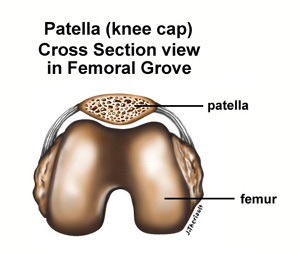Patellofemoral Pain Syndrome
 What is it?
What is it?
Kneecap pain is one of the most common symptoms experienced by athletes. Studies have shown that patellofemoral pain syndrome comprises up to 50% of overuse injuries. This syndrome is caused by irritation of the undersurface of the patella (kneecap) which, in its normal state, is smooth. The irritation can lead to a roughening of the patella undersurface, a condition called chondromalacia.
The patella is a moving part, gliding up and down in a groove in the femur (thigh bone). Pain is caused by pressure between the patella and the groove in the femur. As you bend your knee, you gradually increase the pressure and stress between the patella and the femur. The irritation and roughening of the patella causes inflammation, which leads to pain and swelling. Patellofemoral pain syndrome and chondromalacia are not arthritis. Children and adolescents almost always grow out of this problem.
 Predisposing Factors
Predisposing Factors
- When the patella is not symmetrical in the femoral groove, there is an imbalance resulting in wear and tear. An asymmetrical kneecap is called a “jockey cap” patella. This condition can be identified on x-rays.
- Overuse (especially downhill running)
- Wide hips
- Knock-knees
- Increased Q-Angle: Constructed by drawing a line from the anterior iliac spine (a part of the pelvis) to the center of the patella, then to the center of the tibial tubercle (leg bone). Greater than 21 degrees in females and 18 degrees in males is abnormal.
- Tibial torsion (rotation of lower leg)
- Flat (pronated) feet
- Weak inner thigh muscles
- Previous injury to the knee
Treatment
Treatment is based on two principles: reducing inflammation and improving the dynamics of the patella/femoral relationship.
Rest
When the knee is painful and swollen, you must rest it. Let pain be your guide. You are aggravating the condition if you continue activities while experiencing pain. Mild discomfort or ache is not a problem but definite pain is cause for concern.
Ice
Apply an ice pack (frozen peas work great) to your knee for 15 minutes 2-3 times daily and after any sporting activities. This reduces inflammation and swelling.
Medication
Your doctor may prescribe anti-inflammatory pills to reduce the inflammation. These can be very important.
Physiotherapy
Various techniques can be used to reduce the inflammation. Exercises can be used to stretch and strengthen the thigh muscles. These muscles control the patella in the groove. When thigh muscles are strong, the patella will move through the groove with less pressure.
Surgery
In some cases, surgery may be needed. This is usually in the form of an arthroscopic examination. Occasionally, repositioning the patella is required.
Adjustments
The structure of your foot may also alter the patella/femoral relationship. Some physicians may prescribe specific shoes or orthotics (shoe inserts) to help your problem. New materials (Sorbothane, Spenco) have been designed to fit into your shoe to help absorb the impact as your foot hits the ground.
Sports
There is very little pressure between the patella and the femur when the leg is straight or only slightly bent. The best activities are the ones that limit the knee to a range between 135 degrees (1/4 squat) and 180 degrees (straight).
Good Sports
These sports will be easiest on the knee:
- Swimming (flutter kick, knees straight)
- Slow jogging, walking
- Skating
- Cross-country skiing
Questionable Sports
These sports can be performed by some, but could cause problems to others:
- Cycling (seat high and avoid hills)
- Soccer
- Baseball
- Hockey
- Skiing (downhill)
- Tennis
Bad Sports
These sports are hard on the knees as they include deep knee bends. These sports are most likely to aggravate your condition:
- Volleyball
- Basketball
- Running (sprints, downhill)
- Football
- Racquetball
- Squash
Use your judgment. When your knees hurt, avoid all but the good sports. Total rest may be required. When your knees start to feel better, you should be able to return to all sports.
Exercise
Exercising will help build up the muscles that control your kneecap. Do these exercises daily, as they can definitely help improve your condition.
Stretches
Always stretch slowly, without bouncing, until you feel your muscles stretch. You should not feel pain.
| Single-Quadricep Stretch (A) Standing with your back straight, pull your foot back until you feel your thigh muscle stretch. Push down and back with your knee. Hold 15 seconds and relax. Repeat 3 times. If this stretch causes pain, stop. |
Hamstring Stretch (B) Sit on the floor with your injured leg straight, knee locked, and your other leg bent in. With your back straight, bend from the hips and reach down over your leg until you feel the muscles stretch. Hold 10 seconds and relax. Repeat 3 times. |
Strengthening Exercises
It is important to stay away from strengthening exercises that can aggravate your condition. Here are two that do not involve bending the knee.
| Static Quads Sit on the floor with pillows under your knee. Push your thigh into the floor, raise your heel, and bend your foot back towards you and hold 5 seconds. Change legs or do both at the same time. Repeat 15 times. |
“T” Exercises (D) Sit on the floor with a weight on your leg (2-5 lb kit or handbag). Lock your knee and raise your leg. Draw a “T” with your foot. Repeat with your other leg. Do 3 sets of 10. Increase weight weekly as your strength improves. |